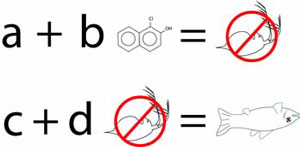Stressor-Response Relationships from Ecological Simulation Models
Concept
Stressor-Response Relationships From Ecological Simulation Models: Within the case, the cause must be at levels associated with effects in mathematical models simulating ecological processes.

Click here to view more information
Examples
Consider increased pesticide concentrations as a candidate cause for reduced insect species richness. What findings support or weaken the case for pesticides as a cause, based on stressor-response relationships from simulation models?
- Supporting evidence - Simulation of the case in AQUATOX, using parameter values (e.g., stressor levels, biotic assemblages) relevant to the impaired site, generates a scenario in which insect richness is similar to that observed at the impaired site.
- Weakening evidence - Simulation of the case in AQUATOX, using parameter values (e.g., stressor levels, biotic assemblages) relevant to the impaired site, generates a scenario in which insect richness is much higher than that observed at the impaired site.
- AQUATOX: Linking water quality and aquatic life
How Do I Analyze the Data?
The use of mathematical models that simulate ecological processes depends on either the availability of a model that adequately represents the case, or the development of an ad hoc model. Model development, implementation and interpretation are specialized skills. As a result this type of evidence may not be used as commonly as many other types of evidence.
Ecological simulation models can be especially helpful when a complex network of events influences the observed effect. Manipulating one potential contributing factor at a time, different scenarios can be modeling to determine how expected effects change. As models of causal processes become more complex, it is increasingly difficult to judge whether an individual model adequately represents the causes of ecological degradation at a site. In such cases, the best strategy is to generate models of each proposed causal pathway, and determine which model best explains the site data.
It is important to avoid adjusting the model's functions and parameters to obtain the observed impairment as an output. Such model calibration negates the utility of this type of evidence.
As with stressor-response from laboratory tests and from other field data, model output is interpreted by comparison to stressor-response information from the case. Although this may be accomplished by comparing point data from the case (e.g., the aqueous concentration at which the number of benthic arthropod species is reduced by 35%) to model output, it is much more informative to compare trends from the case such as changes in the relative abundances of scrapers and collectors along a concentration gradient.
What Evidence Would Support or Weaken the Case for a Candidate Cause?
- Data showing that model simulation of the case (e.g., in terms of stressor or source levels) produces effects similar to the impairment
- Data showing that model simulation of the case (e.g., in terms of stressor or source levels) does not produce effects similar to the impairment
How Do I Score the Evidence?
| Finding | Interpretation | Score |
|---|---|---|
| The observed relationship between exposure and effects in the case agrees with the results of a simulation model. | This finding somewhat supports the case for the candidate cause, but is not strongly supportive because models may be adjusted to simulate the effects. | + |
| The results of simulation modeling are ambiguous. | This finding neither supports nor weakens the case for the candidate cause. | 0 |
| The observed relationship between exposure and effects in the case does not agree with the results of simulation modeling. | This finding somewhat weakens the case for the candidate cause, but is not strongly weakening, because it may be due to lack of correspondence between the model and site conditions. | - |
Helpful Tips
- Model results are seldom convincing alone, but they can strengthen the case for a candidate cause when combined with other types of evidence.
- Note that it is not possible to refute the case for a candidate cause using stressor-response relationships derived from simulation models.
